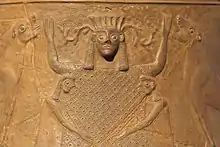
The Potnia Theron (Ancient Greek: Ἡ Πότνια Θηρῶν,[1] [hɛː pót.ni.a tʰɛː.rɔ̂ːn], lit. "The Animal Queen") or Lady/Queen of Animals is a widespread motif in ancient art from the Mediterranean world and the ancient Near East, showing a central human, or human-like, female figure who grasps two animals, one to each side. Although the connections between images and concepts in the various ancient cultures concerned remain very unclear, such images are often referred to by the Greek term Potnia Theron regardless of culture of origin.
The term is first used once by Homer as a descriptor of Artemis[2] and often used to describe female divinities associated with animals.[3] The word Potnia, meaning mistress or lady, was a Mycenaean Greek word inherited by Classical Greek, with the same meaning, cognate to Sanskrit patnī.[4]
The oldest such depiction, the Seated Woman of Çatalhöyük, is a clay sculpture from Çatalhöyük in modern Turkey, made c 6,000 BC. This motif is more common in later Near Eastern and Mesopotamian art with a male figure, called the Master of Animals. Homer's mention of Potnia Theron refers to Artemis; Walter Burkert describes this mention as "a well established formula".[5] An Artemis-type deity, a "Mistress of the Animals", is often assumed to have existed in prehistoric religion and often referred to as Potnia Theron with some scholars positing a relationship between Artemis and goddesses depicted in Minoan art.[3][6]
An early example of Italian Potnia theròn is in the Museo civico archeologico di Monte Rinaldo [7] in Italy: a plate illustrates a goddess that wears a long dress and holds hands with two lionesses.
In the Aeneid,[8] Virgil mentions that inside of Psychro's Cave, in Crete, lived the goddess Cybele whose chariot was drawn by two lions.
 Artemis Orthia in the usual stance of Potnia Theron on an archaic ivory votive offering, (National Archaeological Museum of Athens)
Artemis Orthia in the usual stance of Potnia Theron on an archaic ivory votive offering, (National Archaeological Museum of Athens) Relief on a pithos, 625-600 BC. National Archaeological Museum of Athens
Relief on a pithos, 625-600 BC. National Archaeological Museum of Athens
 Minoan goddess flanked by two lionesses (note the tufted tails)
Minoan goddess flanked by two lionesses (note the tufted tails)
See also
References
- ↑ "πότνια - Ancient Greek (LSJ)". lsj.gr.
- ↑ "Homer, Iliad, Book 21, line 468". Perseus Digital Library. Retrieved 2020-04-13.
Tὸν δὲ κασιγνήτη μάλα νείκεσε πότνια θηρῶν Ἄρτεμις ἀγροτέρη, καὶ ὀνείδειον φάτο μῦθον...
- 1 2 Fischer-Hansen, Tobias; Birte Poulsen (2009). From Artemis to Diana: the goddess of man and beast. Museum Tusculanum Press. p. 23. ISBN 978-8763507882.
- ↑ Chadwick, John (1976). The Mycenaean world. Cambridge University Press. p. 92. ISBN 978-0-521-29037-1.
- ↑ Burkert, Walter (1987). Greek Religion. Harvard University Press. p. 149. ISBN 978-0-674-36281-9.
- ↑ Roller, Lynn E. (1999). In search of god the mother: the cult of Anatolian Cybele. University of California Press. p. 139. ISBN 978-0-520-21024-0.
indefinite figures such as the Potnia Theron
- ↑ "Monte Rinaldo - Rete Museale dei Sibillini". Retemusealedeisibillini.it. Retrieved 11 April 2018.
- ↑ "Virgil, Aeneid Book 3, lines 110-113". Perseus Digital Library.
Further reading
- Douglas Van Buren, E. "Italian fictile antefixes of the Πότνια θηρῶν". In: Revue des Études Anciennes. Tome 24, 1922, n°2. pp. 93–100. DOI: Italian fictile antefixes of the Πότνια θηρῶν; www.persee.fr/doc/rea_0035-2004_1922_num_24_2_2200
- Kourou, Nota. "Potnia figures and cults in early Iron Age Aegean and Cyprus". In: Cahiers du Centre d'Etudes Chypriotes. Volume 45, 2015. Hommage à Jacqueline Karageorghis. pp. 181–199. DOI: Potnia figures and cults in early Iron Age Aegean and Cyprus; www.persee.fr/doc/cchyp_0761-8271_2015_num_45_1_1633